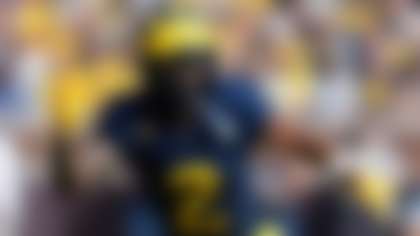Last week, I revealed the five biggest plays of the 1970s. Rolling along in NFL Network's "Decades Month," I was asked to rinse, wash and repeat for the 1980s.
The '70s list featured the incredible and the controversial -- and that's not even counting everything left on the cutting room floor. The '80s roundup forced some difficult omissions, too, like Marcus Allen's spectacular reversal of field in Super Bowl XVIII. (Allen does get some love below, albeit on a teammate's sprint.) Montana-to-Taylor is absent, as well, though the quarterback can be found below on a different play you might recall. And Charles Martin's ignominious dumping of Jim McMahon -- along with the goonish Packer's "hit list" towel -- is noticeably absent.
We can go on and on ...
The overall toughest cut? John Riggins' Super Bowl XVII romp. One more personal favorite? Well, it's actually a combo pack: John Taylor taking two relatively short passes 90-plus yards to the house against the Rams in December of 1989.
Which plays would you feature below (... or remove from my list)? Let me know: @HarrisonNFL is the place.
OK, let's get to it, starting with a big-time run that came just a few weeks before Riggins battered the Dolphins:
5) 'Ninety-nine yards ... and a half'
It was the final week of the strike-shortened 1982 season -- the last day, in fact. Already locked into the No. 2 seed for the playoffs, the Dallas Cowboys hit the Metrodome on Monday night for one last tune-up.
What they got was a speed test.
Trailing the Minnesota Vikings 24-13 in the fourth quarter, the Cowboys were pinned at their own 1-yard line. Dallas QB Danny White called "Dive 21" in the huddle. Fullback Ron Springs was supposed to be in there. He wasn't. Thinking he'd heard "Jayhawk," which called for a single-back backfield, Springs departed White's meeting of the minds. The huddle broke, center Tom Rafferty put his hand on the ball ... and then all hell broke loose.
Tony Dorsett, the single-set back, took the handoff and exploded through the line, running past a couple grab attempts and eating up 10 yards in a half-second. Dorsett darted -- no, glided -- to his right and toward the sideline, racing by a few more Vikings in the process. Suddenly, "TD" was at midfield.
"He's got two men to beat!" Cowboys play-by-play man Verne Lundquist exclaimed, as Vikings defensive backs Tommy Hannon and Willie Teal closed in on the galloping Cowboy. Hannon was about out of gas. Cowboys receiver Drew Pearson -- trying to block 70 yards downfield -- was running on empty, too. Still, Dallas' clutch wideout tripped up Hannon while shoving Teal upfield. Dorsett finished off an exhausted Teal with a stiff-arm while somehow staying in-bounds. A few seconds later, he was in the end zone, receiving a bear hug from Pearson, both men running on the fumes of adrenaline.
It was insane. I watched it on my mom's TV in Dallas, a few short miles from old Texas Stadium. That seems like 99 years ago.
"Ninety-nine yards ... and a half," ABC announcer Don Meredith said in his Mount Vernon, Texas drawl. It would go down as 99 in the NFL record book -- a mark that is literally unbeatable.
4) The Fumble
The millions of fans who watched "The Drive" in the 1986 AFC Championship Game couldn't have expected such theatrics in the '87 title game rematch, especially when the home Denver Broncos took a 21-3 lead into the half.
Then the Cleveland Browns got rolling.
Marty Schottenheimer's club had developed a knack for rallying in the coach's three-and-a-half years at the helm. In the '86 divisional round, the Browns erased a 10-point deficit against the New York Jets in the final four minutes -- and eventually won in overtime.
On this day, quarterback Bernie Kosar led an offensive unit that put up 30 points in the second half alone. Cleveland churned out production through the air and on the ground. Kosar was dealing, completing 26 of 41 passes for 356 yards by game's end, but the real sparkplug was running back Earnest Byner, who was all over the place. He rushed 15 times for 67 yards and a touchdown, but also caught seven passes for 120 yards, including a 32-yard score. He was the star ...
... until he became the goat. Trailing 38-31 late in the fourth quarter, Kosar moved the offense all the way down to Denver's 8-yard line. Facing a second-and-5 with just 1:12 remaining in regulation, Cleveland called a draw to Byner. The play opened up, and the Browns tailback appeared to have enough of an opening to plunge into the end zone and put this instant classic on an overtime track. Byner would have done just that -- had wideout Webster Slaughter executed his block on the left side. According to Schottenheimer, Slaughter got caught watching the action, which allowed Broncos CB Jeremiah Castille to make a play for the strip.
Some fans never saw the fumble.
Denver did, recovering at the 2. Game over.
A truly astounding turn of events. And to Brownie faithful, glaring evidence that their franchise is cursed.
3) Video Bo
If you ever played Tecmo Super Bowl, you know Bo Jackson was a force to be reckoned with in the world of Nintendo -- an absurd combination of Eric Dickerson, Gale Sayers and Earl Campbell streaking across the blurry screen of your Magnavox. Yes, you remember the kid on your street who used to play (unfairly) with "Video Bo." You still dislike him.
In that home-console classic of all home-console classics, there were two "Video Bo" plays to choose from: a sweep to the bottom of the screen and a quick off-tackle to the top of the screen. What happened at the Seattle Kingdome on Nov. 30, 1987 -- in real football -- looked a lot like the latter.
First, the backdrop: The Los Angeles Raiders were up 14-7, and in desperate need of a win. Al Davis' club had lost seven in a row. Jackson was the shiny new toy, having come over to the NFL after completing his first full season with MLB's Kansas City Royals. Yet, in his first four games, the former Heisman Trophy winner had failed to crack 100 rushing yards (mostly because he hadn't gotten the rock enough). This night in Seattle was Jackson's 25th birthday, and while he wasn't three sheets to the wind -- like a lot of birthday boys -- he sure ran like the wind, especially in the second quarter.
Facing a third-and-6 from his own 9, Raiders head coach Tom Flores decided to play it safe: run the football and punt. That's when Bo decided he knew football. After taking the Marc Wilson handoff and heading off left tackle, the rookie back cut inside an excellent Marcus Allen block. As soon as Bo saw an opening, he exploded.
Years later on ESPN, Howie Long memorably described his former teammate hitting that corner: "It's just all thighs and ass." Seahawks safety Eugene Robinson took the brunt of it, getting stiff-armed straight into the carpet. Ninety-one yards later, Jackson hit the end zone ... and kept going, disappearing into the Kingdome tunnel as he downshifted from warp speed.
Bo would never be invisible again -- an icon was born.
Jackson proved on that night that he could indeed dominate football at the highest level, rushing for 221 yards and two touchdowns, famously running right through the ever-confident Brian Bosworth on his second rushing score. The two-sport superstar was upon us. Marketing opportunities flew Jackson's way in the coming years -- before, of course, a hip injury thwarted this superhuman specimen.
Watch Bo's football home run again, and tell me it's not a breathtaking piece of video. Bo Jackson: The most awesome video game athlete -- and maybe real athlete -- of all time.
2) Sweetness beyond 12,312
For years, the number 12,312 loomed over the NFL like 755 shaded every power hitter who even thought about hitting 35 home runs once, much less averaging that figure for over 20 years -- à la Hank Aaron. Walter Payton concerned himself with another sports god:
Jim Brown.
Brown was a giant of the game, a living legend. And though he had been retired for two decades, his career rushing mark -- 12,312 yards over just nine years -- was the sexiest record in the sport. Although not unbreakable, some fans and media alike were worried about who would break it.
Franco Harris had a three-year head start on Payton, but by the 1984 season, the Steelers great had slowed down so much that he was running out of bounds seemingly every other play and truly limping toward the record book.
Payton, on the other hand, had just logged a 1,421-yard campaign in 1983, and was averaging 124.2 yards per game through the first five weeks of '84. Even Brown wanted to see the tough, gutsy fireplug in Chicago -- the guy who sought out contact rather than avoiding it -- get the record.
Against the New Orleans Saints on Oct. 7, 1984, Payton would please everyone -- even some Saints defenders who knew what this record meant. After a productive first half in which he gained 64 yards, it was time to get some accounting out of the way, time to surpass 12,312. He needed just 3 yards.
Payton gained one on Chicago's first play of the second half. On second-and-9, quarterback Jim McMahon called "28 Toss Weak" in the huddle. It was a fairly well-blocked, fairly nondescript play that netted 6 yards -- but of course, it was so much bigger than that. Saints defenders were the first to congratulate him, starting with eventual Hall of Famer Rickey Jackson. Payton's teammates spilled onto the field of play, and the running back executed a picture-perfect, aerial high-five with Todd Bell. The Soldier Field crowd chanted "WAL-TER! WAL-TER!" and even Ronald Reagan lobbed "Sweetness" a call following the game.
Payton's run to the record book might be the least spectacular of the plays on this list. Yet, if the 40th President of the United States felt inclined to chime in, then the number 12,312 clearly transcended sport.
1) The Catch
You're aware of the San Francisco 49ers' dynastic reign. You've heard about Bill Walsh launching the West Coast offense. And by now, you know both developments essentially spawned from Dwight Clark's leaping grab in the 1981 NFC Championship Game.
Have you heard of Dick Nolan? Probably not.
Nolan parlayed his good work as a defensive assistant with Tom Landry's Cowboys into a head-coaching gig with the 49ers in 1968. Nolan retooled the defense, helping San Francisco become one of the NFC's best teams in the early 1970s. Nolan's team made the playoffs in three straight years -- logging consecutive NFC Championship Game berths in '70 and '71 -- only to fall to Landry's Cowboys each time. In the last such occurrence, a divisional-round matchup in 1972, the 49ers blew a 28-13 second-half lead.
It was that history that provided the original context for this epic battle. This was to be the 49ers' time. Walsh's group went 13-3 in the regular season, demolishing the Cowboys 45-14 in Week 6. The '81 NFC title bout, one of the greatest games ever played, didn't quite play out that way. Dallas forced San Francisco into plenty of mistakes -- Joe Montana threw three picks, including a pair to Cowboys rookie Everson Walls -- while the Niners' defense had difficulty with running back Tony Dorsett.
Still, despite Landry's Cowboys showing up at Candlestick with designs on securing a sixth Super Bowl berth, it would be the 49ers going to their first after this day ... and play.
Trailing 27-21 with 4:54 to play, Montana marched the 49ers 83 yards down the field, utilizing the run and short passing game. Facing a third-and-3 with just 58 seconds remaining, Walsh called "Red Right Tight -- Sprint Right Option." Wide receivers Dwight Clark and Freddie Solomon both lined up on the right. The play called for Clark to start left, then cut back across the back of the end zone. Solomon, the primary target, was to run, essentially, a simple out pattern.
Dallas had Solomon bottled up. With his first option covered, Montana kept drifting right, with three Cowboys hot in pursuit -- one of whom was 6-foot-9 Ed "Too Tall" Jones. The big defensive end raised his arms, but the savvy Montana got Jones to leave his feet with a pump fake. As soon as Jones landed, the 49ers quarterback released a high ball where only Clark could get to it.
He did.
Splashed across every sports outlet, including the cover of Sports Illustrated, what Clark did became known as "The Catch" -- and jump-started a dynasty.
Meet the new boss, not the same as the old boss.
Follow Elliot Harrison on Twitter @HarrisonNFL.












